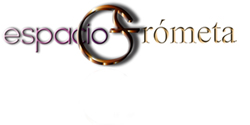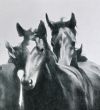FRONTAL TROT
Jorge R. Bermudez
Writer, Art Critic. Art and Comunication Teacher
at the Comunication Faculty in the University of Havana, Cuba.
The horse became to be part of the man's art work, a lot before he saddled it for his conquest wars and expansion. From the parietal cavalcade from Lascaux to the momentous neigh of the wounded horse in Guernica, each time and culture has had its equine canon. Cuba, that languished of horses after two long and bloody wars for the national independence, made him a place in its art, from the work and grace of Carlos EnrĂquez' avant-garde landscapes paintings. With the revolutionary victory in January 1959, the horse continued its pictorial career, but only like complement or relief on the preferable topics of this historical moment, for instance the Servando Cabrera Moreno's Militiamen painting series. Its autonomy as a matter in art was still to be demonstrated. A painting between hedonist and epic poetry began as preferential treatment in those themes given more to be related with the social thing. The heroes of every day and those of all times moved in power vehicles. It seemed that horse would be outside of the best Cuban art; unconcluded its trot, without testimony its loyalty. The political, social and historical mission was very present in all the people, waiting everything of art from the beast. Just then, the first flashes of a painting that assumed the cult to the vitality were given, starting from the sovereign presence of the equestrian topic. This painter was Gilberto Frometa Fernandez (1946).
Frometa, as everyone calls him, belonged to the first promotion of artists formed by the revolution. His first one man show dates from 1970. But, it wasn’t until 1979 that his work heads toward the mentioned thematic. Frontal Trot and Paint With Nude corroborate this year as the definitive road on the topic in which the painter has been more occupied in his artistic life. Both drawings, made with pen nib and ink on paper, for the monochromatic line and the theme, unwittingly predate the receiver to the most remote ancestor of the modern plastic artist's: the cave man painter; in same way, the realism. Lastly, both drawings, when identifying this genitive stage of Frometa with the technique and the aimed style, will also relate him with the two manifestations that have always been spiritual and conceptual rim of his professional trajectory: graphic and photography.
The photorealism or hyperrealism, as it’s notorious, present in the international artistic scenery since the exhibition Documents V, in Sidney, Australia (1972), was welcomed then with the aesthetic searches of the Cuban art. Without obviating, in this point, the relevancy of photography, in particular, the photographic reporter, as visual driving force nucleus of the Cuban vanguard poster design. Not few painters that made graphic and not few graphics that made painting - present duality in the Cuban visual culture since the colonial period-, saw in this last tendency in the international art as a gold mine to approach the enormous Cuban reality of that moment from a figuration more or less objective, contrary to the socialist realism itself, with which each other confronted daily, will consent the requirements of form and content of an essentially contemporary and Cuban aesthetic-communicative practice. This way, the topic of the horse, since then little or not well tried by the vernacular art, was assumed by Frometa the drawing -many of these works had as first reference the technical image of a photography-, relating it stylistically with the photorealism, in other words, with the international vanguard tendency of the plastic arts in the 70th of the past century.
However, that which most calls the attention in this stage of Frometa, is the induction of a topic, with a most remarkable historical visual load, in the history of art, from a realism of great vitality and subjective intensity. Violence, 1977, a drawing, is a proof of this. The single head of the horse is able to generate an endless number of associations and relationships that go beyond the fury of the animal, to be also symbolic representation of a state of the human existence.
To the exaltation of this realism, in a same way contributes, the elaborated design that each one of his representations sustains. The form is, once seen the drawing, another surprise. Anything anecdotic neither descriptive, to its essential expressive force add the artist's carefully worked occupation, so much to represent the animal, isolated or in group, as well as to unmark it from common places, without the presence of the always uncertain label of the beautifulness. Beauty is honesty, no more, no less. From there are the aesthetic and communicative values that the artist is able to transmit in each work.
After the drawing - even in paintings, like it will be seen later on -, the form remains, the drawing itself, the message, the surprise of an expression: the animal's and its relationship with strategies of visual code that don't disregard even for a moment the effectiveness of a blank space, the crack of a line made as a flight, or the diaphanous transparency of a throng of on inks in function of the dominant address in each composition.
Toward 1980, Frometa once again, adventures in the engraving world. In this moment the experimental interest as in other occasions, will show when he appeals to chalcography giving continuity to the favorite thematic, with which had learned how to mate with drawing, reality with poetry, beginning with pen nib and the Indian ink. Stein (1980), it's of an impeccable design.
Follows Steed (1984) and Jealousy (1987), this last one as a messotinta, with certain expressionists values in the lines, precursor of changes in the horse theme, in particular and of Frometa’s plastic work in general.
The year is more than significant. The disintegration of the European socialism will influence in a decisive way the whole Cuban society. A new generation of artists formed with the revolution, praise a change in the form of approaching the domestic reality through art. To which also contributes the entrance of the Cuban art to the international market. The most original artists in the precedent generation, will find in this period their moment of bigger creative maturity, in which they end up defining their respective poetic visual. The twisting point is made evident to all, even to those that ended the century in the 60. Each one designs a personal strategy to face the crisis (of the Greek krinos: possibility for the change); but all, without exception, accelerate the desires of living, well to live it or to lose it forever (the aids, the rafters). For Frometa, it's returning to abstraction. His form of facing the new reality through art, becomes new form of reality. There is nothing better than starting from zero. In a short television documentary in that period, he can be seen, agile, nervous, paintbrush in hand in front of the canvas, creating visual textures, dripping, gestural forms that countersign a cycle of his visual creation unpublished till then. At the end, in the television screen, only a great abstract painting is observed. Nothing is better to readjust the style, to give continuity to it, to recreate it than the asepsis of abstraction. From it he will become renovated.
In fact, approximately between 1993 and 1994, the change begins. That is to say, the twist from this work to forms of visual representation related with a figuration more or less objective. Before Galloping, Trot, is the clue piece. The title is an entire manifesto. The trot before the gallop, will mean to Frometa to involve his favorite topic, the horse, in a reality in bid with the past and the present which will make the art of the 90, a new significant moment of the Cuban visual culture: contingency limit of the spirituality of a nation made and thought through the universal idea.
The beginning cannot be better: a realism different to that of his drawings and engravings of the 70 in which change is also implicit a new technique and support: oil and canvas. New decade, new life. The equine saga, contrary to the properly photorealistic period of this --in more than one sense, formative--, will be seen now sustained by a visual speech of strong symbolic load. More reflexive than literal, the matter will be impregnated of interrogations, with which enlarges and make difficult that which had begun in the previous decade. The color, in such paintings, will be inseparable part of the new language, of the new reality. The extended paint stroke or the unfinished touch, and even certain textural contrasts, nothing unaware to those chromatic freedoms won through the abstraction, they are aiming either to reconcile the form with the message, as well as to accelerate the visual journey in correspondence with the dynamics and dramatic that distinguish the topic.
In this new pictorial period, the wooden horse roundabout or Mary-go-round, centers the visual universe in a true plastic matrix, in which all the profit of experiments and the most decanted influences converge. From there the first symbol condition, in a distressed moment of childhood, in which, the stunt (the wooden horse), until then fixed as stalactite to the roof, becomes breakage, breakaway from the circle, solidarity of the alive with life, stampede -with those of its specie- toward freedom. Without being moralizing, the moral component that travels over these paintings becomes axis rector of the message. Also, the man's growing presence. But, beware; not as the message protagonist, but as a visual counterpoint with the real and total subject of it, the horse. The man not as individual, but as group, depersonalized, anonymous, on the other hand, each horse, either wooden or real, has its own personality. In which side is the reason? In which, the reasoning? Ancient Light (1996), gives beginning.
The symmetry of the conflict, more than real, it is poetic. The truth of life being revealed through the "lie" of art: real nature of the fiction. The true horses help the handcuffed wooden ponies to break the closed circle of the show, of the Mary-go-round. The stampede is the pre-figuration of the next freedom to live. From Wooden Tordillo to End of Century’s Tordillos (1999), through Top Hats, Sincere Rupture and Party, the symbolism increases the plastic matrix of the pointed visual universe, pushing it to the boundaries of the unreal, or surrealism. In the derby, under the chisteras, (top hats) wave, man becomes formless, gray... Men make the solitude; horses make feelings.
To them he always turns -as Frometa’s pictorial way of saying- without prejudice of the person or the loved landscape, because they only know the road that leads to the place where they were happy once. There, where the true man also reigns, the forever one, the last stamen is broken by the burst of the liberated horses, and recognizes the son, the woman.
Because of them (the horses), man sits to walk, to dream: their dreams are straddles and the instilled freedom to make them reality, pure animal instinct. Atrevido (Daring) (2001), is the new rupture, starting again from where the dream left intact the child, full on his royal mount, in the prince photography of childhood. Its advance is impetuous, unrestrainable. It always costs too much to go back to what is lost. But, if returns, it is possible that the world be an immense cave, where man, already free, only paints horses.
 frontal-trot.pdf, Download complete illsustrated text
frontal-trot.pdf, Download complete illsustrated text





